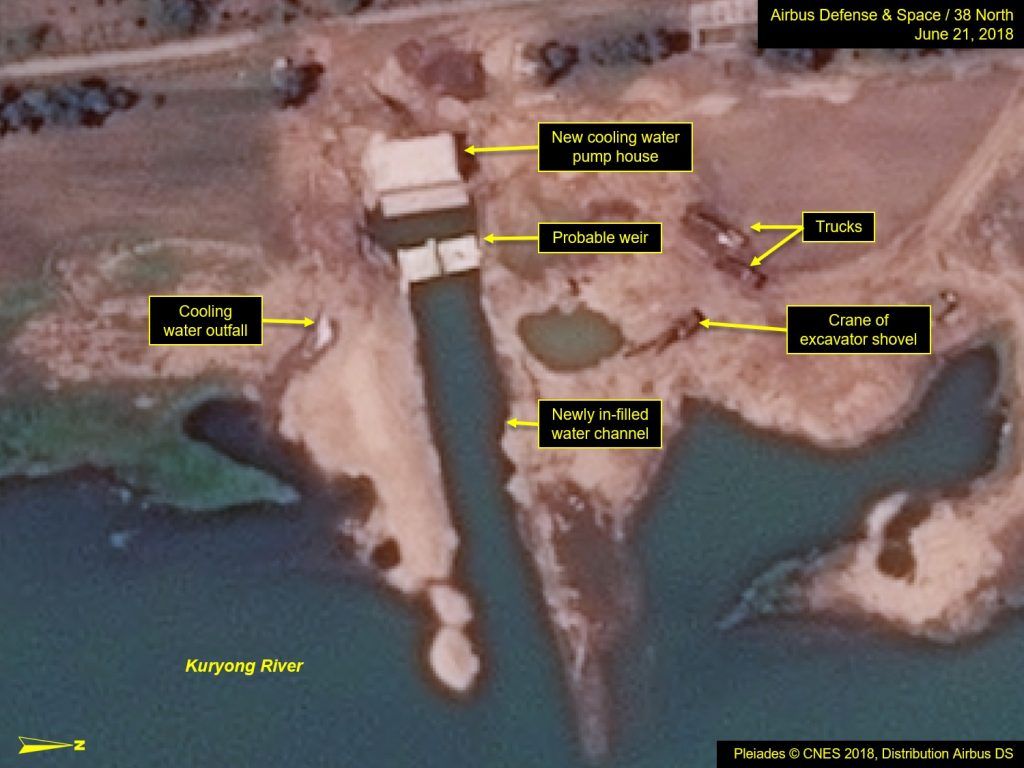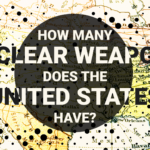North Korea is not denuclearizing. Yet.
By Dawn Stover | July 3, 2018
 Close-up of new cooling water pump house and in-filled water channel at North Korea's Yongbyon nuclear facility. Credit: Airbus Defense and Space/38 North
Close-up of new cooling water pump house and in-filled water channel at North Korea's Yongbyon nuclear facility. Credit: Airbus Defense and Space/38 North
US Secretary of State Mike Pompeo will visit Pyongyang later this week to “continue consultations and implement the forward progress made by President Trump and Chairman Kim” at their June 12 meeting in Singapore. For now, though, North Korea is not making any unilateral moves to dismantle its nuclear arsenal.
On June 27, the Wall Street Journal reported that North Korea is upgrading infrastructure at its Yongbyon Nuclear Scientific Research Center, the country’s major nuclear facility. The improvements include several new buildings and modifications to the plutonium production reactor’s cooling system.
Two days later, NBC News reported that, according to unnamed US officials, “US intelligence agencies believe that North Korea has increased its production of fuel for nuclear weapons at multiple secret sites in recent months—and that Kim Jong-un may try to hide those facilities as he seeks more concessions in nuclear talks with the Trump administration.” The officials told NBC that North Korea is attempting to “deceive” the United States about the numbers and types of warheads, missiles, and facilities it has.
And on July 1, the Wall Street Journal reported that North Korea “is completing a major expansion of a key missile-manufacturing plant.” The report suggests that North Korea is moving forward with its weapons program even as high-level talks with the United States are scheduled to continue.
Together these reports paint a very different picture than Trump’s post-summit tweet stating that North Korea was “no longer a threat” and his comment to reporters that he had “solved” the North Korea nuclear problem. However, the recent moves by North Korea are not necessarily a violation of the commitment made by Kim, in his joint statement with Trump at the Singapore summit, “to work toward complete denuclearization of the Korean Peninsula.” That vow was a vague one, with no stipulated timetable or verification process. (On July 1, Trump national security adviser John Bolton suggested that Pompeo would be proposing a plan for North Korea to dismantle its nuclear weapons and ballistic missiles within one year, but a verifiable process would likely take much longer than that.)
The June 27 Wall Street Journal article was based on new satellite imagery posted a day earlier by 38 North, a highly regarded website published by the Stimson Center and devoted to North Korea analysis. The 38 North analysis explicitly noted that ongoing work at Yongbyon “should not be seen as having any relationship to North Korea’s pledge to denuclearize. The North’s nuclear cadre can be expected to proceed with business as usual until specific orders are issued from Pyongyang.”
As a June 29 article in Slate reminds readers, “that’s the point: No such orders have been issued—nor can any be expected any time soon, as the statement that Trump and Kim signed is not remotely a deal.” In an email to the author of the Slate piece, Siegfried S. Hecker, who is a former director of the Los Alamos National Laboratory and has visited North Korean nuclear facilities multiple times, put it this way: The North Koreans “have not yet declared that they would shut the complex down—and, indeed, they have not.”
Even the much-discussed satellite images provide little information about what is actually happening on the ground. Only international inspectors, allowed inside the facilities by mutual agreement, could do that. And with US-South Korean military exercises canceled, and Chinese and South Korean sanctions easing, the North Koreans have no immediate incentive to take that step.
Publication Name: Slate
To read what we're reading, click here
Together, we make the world safer.
The Bulletin elevates expert voices above the noise. But as an independent nonprofit organization, our operations depend on the support of readers like you. Help us continue to deliver quality journalism that holds leaders accountable. Your support of our work at any level is important. In return, we promise our coverage will be understandable, influential, vigilant, solution-oriented, and fair-minded. Together we can make a difference.
Keywords: North Korea, Singapore Summit, nuclear weapons, satellite images
Topics: Nuclear Weapons, What We’re Reading















